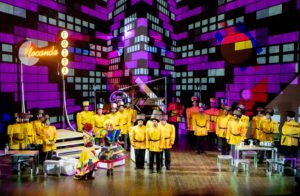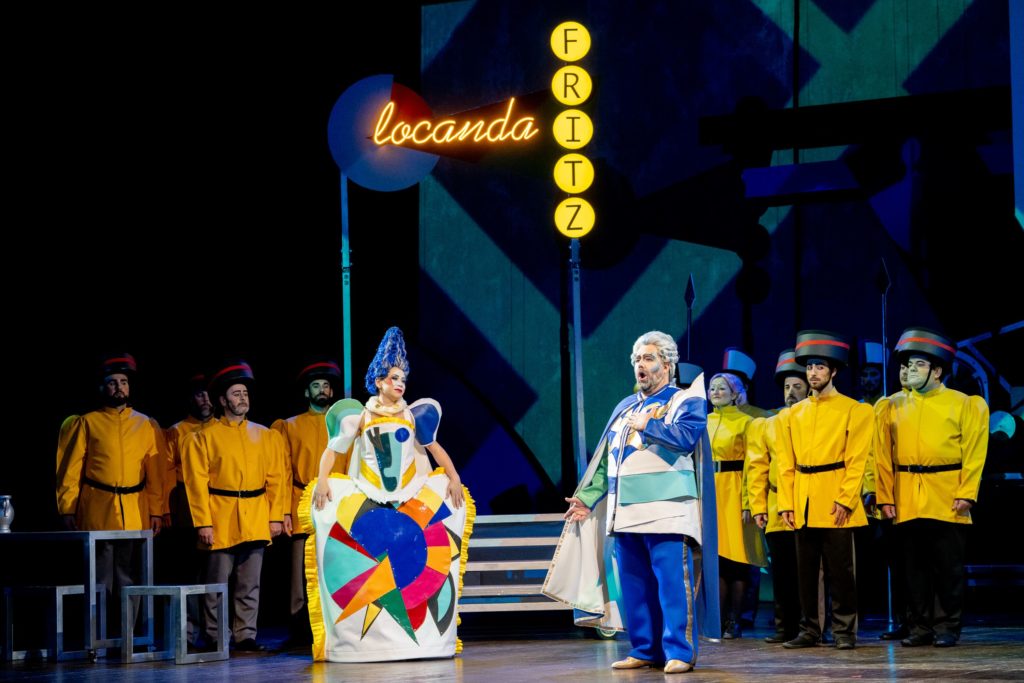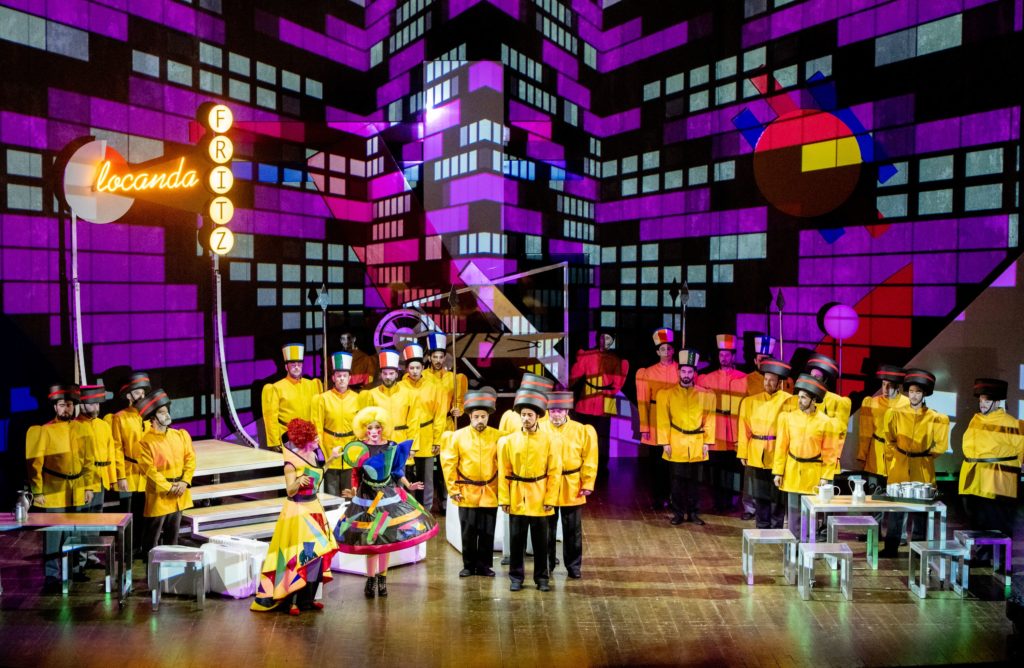
Donizetti Opera Festival 2019 Review: Pietro Il Grande
A Solid Cast Leads An Incoherent Production
By Francisco Salazar(Credit: Credit: Ph. Rota)
In 1819 Donizetti wrote the opera “Pietro il Grande.” The opera was his fourth in what would become a legendary output with some major repertory staples.
To celebrate the 200th anniversary of the opera’s premiere, the Donizetti Festival Opera performed the work in a new production by Ondadurto Teatro – Marco Paciotti and Lorenzo Pasquali.
The result was a lackluster showcase with a solid cast led by Rinaldo Alessandrini’s steady conducting.
The Opera
Like many composers at the beginning of their career, this work lacks a real identity. Donizetti infuses elements from Rossini and Mozart’s music with a glimpse of what Donizetti eventually would do, particularly in Madama Fritz’s Act two aria which starts out with a fluid melodic line that he develops and eventually transforms into a cabaletta. The Act one duet duet between Pietro il Grande and Ser Cuccupis also gave audiences a preview of elements of the patter duet in “Don Pasquale.”
But overall this work is representative of a composer trying figure to his identity while employing the well-known elements of the past. For example, “Pietro Il Grande” only uses a male chorus and has an overall lighter sound that is dominated by wind instruments. The vocal line is also filled with patter and coloratura roulades throughout that Donizetti would eliminate in some of his later works as he aimed for more sustained lines. All of these aspects seem to be embedded with Rossini’s signature.
The story is also a bit incomprehensible, particularly at the beginning as a total of seven characters are balanced throughout. It isn’t hard to lose track of who is who and why they matter.
But the reason for the presentation of this work is important as it gives a window to audiences into where Donizetti came from and where he would eventually go.

Incomprehensible Production
The biggest problem of the night came with the new production by Ondadurto Teatro. The company, which is known for its multidisciplinary approach, used a number of elements in the production including trapeze artists, lighting effects close to those of strobe lights, avant garde costumes and paintings and staircases. All these elements were inspired by Russian culture and according to program notes, the reason behind the use of these elements was also Peter the Great himself who broke with tradition and who changed his empire by creating a modern country.
But the result was confusing as it came off as a jumbled mess of elements moved around to change the scene without ever focusing on the story. If “Pietro Il Grande” already has issues with its libretto juggling too many characters and working with hidden identities, the production didn’t help as it insisted on keeping its singers static and giving them stock movements without any real motivations. It didn’t help that the costumes were the same throughout. Not even Pietro, who hides his identity from everyone, gets to show a different look.
Donizetti intended this opera to have comic elements but at no point do we get any such moments from the direction; instead we get distractions. One such moment came during Annetta Mazeppa’s Act one aria “Scherno saro di questo pazzo ancora?” As soprano Nina Solodovnikova sang her lines, a trapeze artist performed alongside her, taking away the attention from the singer. It was as if the directors didn’t have confidence in the music or the singer showcasing the emotions the passage conveys.
Another big issue in the production was the use of lighting. Every time there was an aria, the director insisted on using some type of lighting effect to enhance the music. After a while, it got predictable, creating diminishing returns on the viewer. The best use of this was the Act one finale where there is chaos within the characters and the strobe effect was used to highlight this confusion.
The costumes did not really say much about the characters. They were filled with metallic silvers and extravagant blues, pinks, yellows, and greens, among others. It all felt like the directors were more interested in bringing a runway show to the theater than to really tell a coherent story. Perhaps this is their style and the way they present theater. However, for this particular opera, it felt like the they didn’t trust the material and needed to add extra oomph to retain viewers’ attention.
A Solid Cast
Despite all the mishaps of the production, the Donizetti Opera Festival lined up an excellent cast of established singers and rising stars.
In the title role, Roberto de Candia showcased a virtuosic and powerful baritone that easily handled the fiortura and patter work that Donizetti assigns the role. During his opening aria De Candia gave a balanced portrayal mixing the serious with the buffo and showing off impeccable coloratura runs. But it was his Act one duet “Ser Decuppis siete voi?” with Macro Filippo Romano’s Cuccupis that was really the vocal highlight of the evening. This duet showcased both baritones bringing a mix of coloratura and patter work that displayed the two characters’ authoritative presence and the flexibility of their voices. The two baritone’s voiced blended beautifully, creating a showstopping moment in the evening.
As Madama Fritz, Paola Gardina had the most developed character and music of the evening. Gardina’s opening aria showcased a singer in a more playful singing with a lighter coloratura line and flexibility that brought out a bit of coquettish spirit that would be seen in Act two. In the Act one duet with Francisco Brito’s Carlo, Gardina conveyed a warmer mezzo and one that displayed the maternal affection conveyed in the duet as her Fritz comforted Brito’s Carlo.
In Act two, Gardina got to show off more of her comical and dramatic side. In her duet with Cuccupis, Gardina flirted with Romano’s Cuccupis at one point, suggestively taking off part of her dress in front of him. She sang with a lighter voice throughout the staccati lines, further emphasizing this fun quality that matched up with Romano’s Cuccupis desirous magistrate. Gardina also displayed flexibility in her coloratura line during the coda of the duet.
In her final aria “In questo estremo amplesso,” the mezzo brought a gorgeous and crisp legato line that expressed the sadness of Madama Fritz as she realized she would never see Carlo again. In the cavatina, she sang with drive that explored the mezzo’s power; the repetition was a showcase for her virtuosity.
In the role of Carlo, Francisco Brito showcased an elegant tenor, though his high notes often seemed a bit constrained and lacking in color. Still, in Brito’s Act two aria, the tenor delivered beautifully flowing pianissimo lines. Brito took advantage of the phrasing by extending some lines with beautiful decrescendos. In the cavatina, Brito contrasted his singing by delivering a heroic tone that showed not only bright high notes but also polished coloratura.
In the role of Caterina, Loriana Castellano performed with a comic touch, particularly in her Act two aria that was reminiscent of Berta’s solo in Rossinis’ “Il Barbiere di Siviglia.”
Nina Solodovinkova also brought a vibrant coloratura soprano to the role of Annetta particularly in her Act one aria. Here she used the line to her advantage as her soprano moved with great flexibility, her timbre melting from one phrase into the other; she also interpolated some potent high notes.
As noted, Romano’s Cuccupis was the comic highlight of the evening, bringing an exaggerated cockiness to his role. He was imposing and serious but that added to the absurdity of his actions. One such moment came in the Act two duet with Madama Fritz where he believed to have control of the situation as he chased her around the stage. Vocally he displayed an impressive control of the coloratura line and patter, especially in the aforementioned Act one and two duets. It almost seemed like Romano was tireless and could continue to sing through the daunting and virtuosic music.
In the pit Rinaldo Alessandrini led a steady performance. He tended, however, to get ahead of his singers, particularly in Carlo’s aria where there was a clear moment during which the orchestra went ahead of Brito’s slight ritenuto. Still Alessandrini should be commended for putting together the various ensembles. He gave every singer the time and space to sing through the fast staccati lines while still moving the orchestra forward and never losing balance. He also adhered to the Rossinian crescendoes, slowly building to the forte with each voice adding to the dynamic of the ensemble.
For any Donizetti lover, this is a curiosity that should be heard as it adds to a better understanding of the development of one of the most beloved composers in the world. While this new production brings nothing new to the story or the music, the outstanding cast is not be missed.



